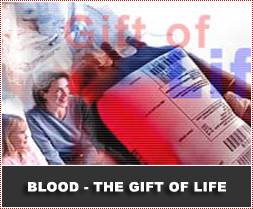Road Safety And The Need For Blood
 Blood is vital to human life. It carries essential nourishment to all the tissue and organs of the body. Without it, the tissue will die. The average person has 25 billion red blood cells and, in a normal healthy person, cells are constantly regenerated in the body.
Blood is vital to human life. It carries essential nourishment to all the tissue and organs of the body. Without it, the tissue will die. The average person has 25 billion red blood cells and, in a normal healthy person, cells are constantly regenerated in the body.
Without the protection of blood, no child could be born. In the womb, the mother’s blood ensures that the foetus is supplied with oxygen and nutrients and benefits from the mother’s inbuilt defences against disease.
About 45 per cent of the total volume of blood is made up of:
- Red blood cells
- White blood cells
- Platelets
The remaining 55 per cent of the total blood volume is plasma, which is the liquid portion in which the cells are suspended.
Red blood cells carry oxygen. The haemoglobin, which gives blood its red colour, is the agent that needs to be present for oxygen to be taken up from the lungs. Red blood cells also transport carbon dioxide back to the lungs, for expulsion from the body. Iron is a key factor in the manufacture of haemoglobin. When iron supplies are deficient, people become anaemic, with a corresponding loss of oxygen-carrying ability.
White blood cells defend the body against disease. They make antibodies and fight infections.
Platelets help to control bleeding by sticking to injured surfaces of blood vessels, and allowing clotting factors to accumulate at the injury site.
Plasma is a fluid, which carries all these cells, plus other substances such as proteins, clotting factors and chemicals.
Sometimes, through trauma such as haemorrhage, the volume of blood in the body is reduced to such a level that the body cannot replace it fast enough. Occasionally, some components of the blood are lacking and do not function correctly, as is the case in haemophilia, where clotting of the blood does not occur. At other times, the bone marrow does not produce sufficient haemoglobin, due to a deficiency of the necessary building blocks. In many of these cases, blood and blood components will be transfused to patients. All the different components of blood can be used and each plays an important role in saving the lives of different individuals in the community.
-::- Blood components -::-
Whole blood is still frequently used for transfusion, particularly where blood services have limited facilities and resources, but the processing of units of whole blood into their constituent components is becoming more common. Depending on their clinical condition, most patients need only one component or product, so this process enables a unit of whole blood to be used for more patients.
The table below gives some examples of blood components and their main uses. This is not a comprehensive list, but gives a brief indication of the principal components.
| Blood component | Main uses |
|---|---|
| Red Cell Concentrate | Severe haemorrhage which causes anaemia, for patients with surgical, abortion or childbirth complications, trauma, cancer |
| Platelet concentrate | Severe haemorrhage through platelet deficiency, leukaemia, cancer, bone marrow deficiency |
| Fresh frozen plasma | Patients with deficiency of coagulation factors, or for the manufacture of plasma derivatives |
| Cryoprecipitate | Haemophilia, von Willebrand disease |
A number of blood products, which have specific uses, can also be derived from plasma.
| Blood products derived from plasma | Main uses |
|---|---|
| Immunoglobulins | Patients with immune system deficiencies, after exposure treatment |
| Albumin | Burns, hypoalbuminaemia, haemorrhage, shock |
| Coagulation factors | Haemophilia and other coagulation disorders |
Blood and blood products are also used for the prevention of conditions that might otherwise result in severe morbidity or mortality. Every minute of the day, blood products are being used for people who are exposed or at risk. Immunoglobulins fall in this category, which are used, for example, to treat abnormal functions of the immune system. Many haemophiliacs are able to lead normal lives if they are given clotting factors such as Factor VIII, a blood product derived from plasma.
-::- Blood as therapy -::-
Blood transfusion is regularly used in cases of surgery, trauma, gastrointestinal bleeding and childbirth to replace major blood losses. Cancer patients also often require blood transfusions. Some genetic disorders affect the blood, such as thalassaemia and cell disease. The shape of the blood cells may be affected, leading to their impaired functioning and consequent destruction. Persons with these disorders require regular supplies of safe blood to replace their deficient blood.
The blood used for transfusion must come from healthy people with healthy blood. Blood is not only a living tissue but also a renewable one, with healthy people having the mechanism to make more blood. By donating blood, the gift of life can be given easily given without fear of regular blood donation weakening a person.
Did you know?
- Blood contains approximately 4 to 5 million red blood cells per cubic mm, 4000 to 11 000 white blood cells per cubic mm, and 150 000 to 400 000 platelets per cubic mm!
- Red blood cells live for about 120 days, and white blood cells 3 to 9 days.
For more information on blood donation or your nearest blood donor centre, call South African National Blood Service [SANBS] toll free at 0800 11 9031 or visit www.sanbs.org.za











